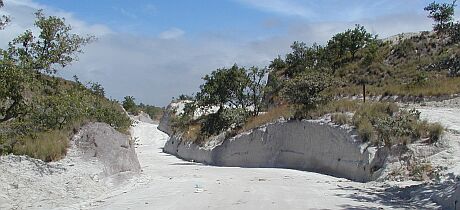
|

Structure, Petrology, and Paleomagnetism
Paleomagnetism/Environmental Magnetism
Magnetic properties of iron oxides found in naturally occurring sediments
have been shown to reflect changes in environmental processes operating
on the Earth's surface. Research in the state-of-the-art Environmental
Magnetism Lab is focused on the application of magnetism to understanding
these global environmental processes. Much of our work is concentrated on
investigating sediments from loess sequences and caves in the Czech
Republic as well as local sediments from Lake Superior and lakes from the
Keweenaw. More traditional research in rock and paleomagnetism cuts across
many disciplines within the department so our students can work toward
degrees in either geophysics or geology.
We have ongoing projects to
determine the effects of alteration on magnetic properties of the oceanic
crust, to investigate the magnetic properties of tephra, to evaluate
landslide potential on volcanic islands such as Hawaii, and to decipher
the details of apparent wander to gain insight into the relative motion
of lithospheric plates, and to understand geomagnetic field behavior. Our
laboratory is equipped with a fully automated 2G Superconducting Rock Magneto
meter housed in a magnetically shielded room(ambient field < 500 nT),
a vibrating sample magnetometer, a spinner magnetometer, susceptibility
bridges, thermal and alternating field demagnetization equipment, and
field equipment.
Research Grants
National Science Foundation, $129,000, 7/15/98 -
6/30/00, Acquisition of a Superconducting Rock
Magnetometer and a Field-Free Room, $209,00
MTU cost-share, J. F. Diehl and S. Beske-Diehl.
National Science Foundation, $71,894, 5/1/97 - 5/31/00, Magnetic
susceptibility variations in cave sediments from the Moravian Karst,
Czech Republic: A record of environmental change?, J. F. Diehl.
TOP
Mineralogy and Petrology
Mineralogical research centers on the world class A.
E. Seaman Mineral Museum (include a link to the
museum's web page) on campus. This research
includes characterization of new mineral species as
well as descriptive mineralogy and the paragenesis
of both classic and new mineral occurrences.
Current work centers on the mineralogy of Canada's
Grenville Province and the St. Lawrence Lowlands
of northern New York State, and includes
investigations on naturally occurring spherical
graphites, and lead and other hydrothermal vein
minerals. Research in clay mineralogy has covered
a wide range of topics including:
1) Modern
sediments in Lake Superior, as part of a multi-
departmental investigation into the origin of the
Keweenaw Current and its impact on sediment
dispersal in the lake;
2) Clay diagenesis in
petroleum fields (Gulf Coast, North Sea, and
Michigan);
3) Layer silicates in ore deposits and the
White Pine copper sulfide deposits;
4) Clay
minerals in geothermally altered volcanic and
sedimentary rocks; and
5) Identification of clay
minerals in soils as part of geological engineering
site investigations.
Many of the clay mineral
investigations are part of larger mineralogical and
petrological investigations into sedimentary
diagenetic systems, as well as geothermal systems
and ore deposits. These investigations utilize a
wide range of tools including Optical Microscopes,
Scanning and/or Transmission Electron
Microscopes, Electron Microprobe, and X-ray
Fluorescene Analyzers, as well as a very well-
equipped Petrographic Image Processing facility.
Most investigations in Metamorphic Petrology have
emphasized low-grade metamorphism in
sedimentary and volcanic rocks. Most Igneous
Petrology is a component of volcanic hazards
investigations, to establish the past history and
eruptive style of volcanoes under investigations.
Petrologic research is also a major component of
field investigations of Precambrian metamorphic,
plutonic, and fold and thrust belts of the Great
Lakes region.
Structure
Studies in structural geology involve microscopic to tectonic scale
investigations in the field, augmented with laboratory work. In the masters program,
thesis typically involve field mapping of Penokean and Keweenawan
age Precambrian rocks that have complex structural histories. These upper
Michigan projects typically consist of a few kilometers of river section
containing polyphase fold structures and foliations and complex fault
development. In some cases, when markers are available, measurements of
finite strain are correlated with the structural history. Numerous structural
problems remain in the proterozoic belts, including thrusting relationships
in the cover rocks and details of basement deformation.
TOP
Use
the Contact Form
for an inquiry
if you are interested in this field.
|
|
Modified on October 15, 2009
Copyright © 2009
Department of Geological/Mining
Engineering & Sciences
630 Dow Environmental Sciences
and Engineering Building
1400 Townsend Drive
Houghton MI, 49931-1295
Telephone: 906-487-2531
Fax: 906-487-3371 College
of Engineering
Michigan Technological
University is an equal opportunity
educational institution/equal opportunity employer.
If you have comments, corrections or suggestions send to:
geo@mtu.edu |
|
|

